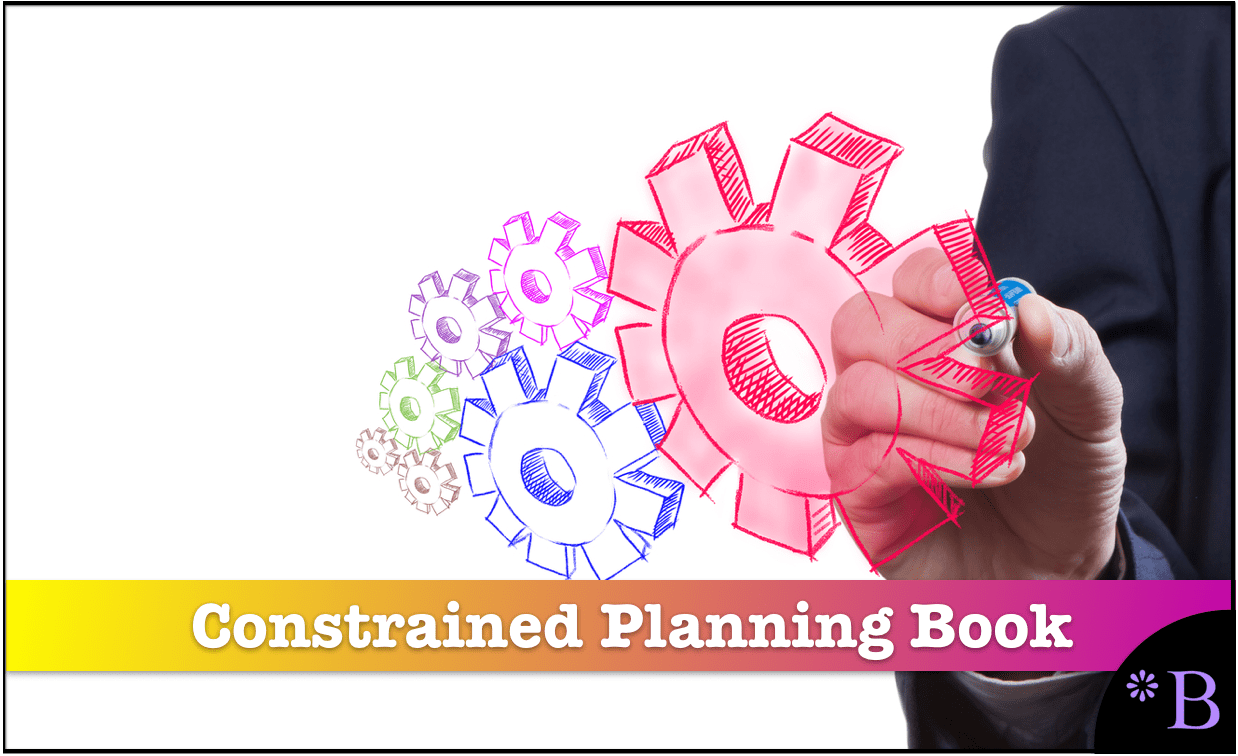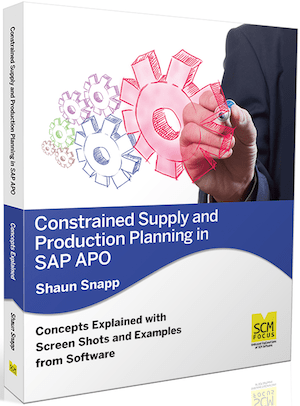
Constrained Supply and Production Planning in SAP APO
Screenshots and examples from SAP APO.
What This Book Cover
Constraint-based production planning generates something that is appealing to all manufacturers: an available supply and production plan. However, constraint-based planning software was first implemented over twenty years ago, and yet few companies have mastered constraint-based production planning.
This book provides background information, detailed explanations, step-by-step examples, and real-life scenarios. This is all to assist a company in becoming proficient at constraint-based production planning, along with valuable information about what SAP APO can do for supply and production planning in reality, rather than just in theory.
Here you will learn about resources—the mechanism for constraining the plan in APO and for determining the feasibility of the plan—and how constrained supply and production planning work together (and how they don’t). Also, this book talks about constraint-based production planning at the supplier level: can a vendor’s production be capacity-constrained?
By reading this book, you will learn:
- The different resources available in APO, how production resources differ from supply planning resources, and the role resources and other essential constraints play in constraint-based production planning.
- How constraints integrate across the supply planning and production planning applications.
- The areas of disconnect between supply and production planning applications, and between SNP and PP/DS in particular.
- The difference between unconstrained (or infinite) planning and constraint-based production planning.
- The benefits of constraint-based planning and how it differs from capacity leveling.
- Various types of demand and how backward and forwards scheduling work.
- The benefits of using production constraints in the supply planning system and how SNP and PP/DS can be synchronized to produce the desired output.
- The methods that can do constraint-based production planning in SNP and PP/DS—heuristics, CTM, and optimization—and how to configure these methods.
- The difference between hard and soft constraints and how to plan using multiple constraints.
Buy Now
A Book Based in Reality
The book provides many examples from real-life project experiences, the emphasis being on the reality of APO projects.
Interconnected to Web Information
In order the keep the book at a manageable and easily readable length, the book also provides numerous links out to the SCM Focus site, where supporting articles allow readers to get into more detail on topics that interest them.
Chapters
- Chapter 1: Introduction
- Chapter 2: Understanding the Basics of Constraints in Supply and Production Planning Software
- Chapter 3: Integrating Supply and Production Software with Constraints
- Chapter 4: Constraint-Based Methods in APO
- Chapter 5: Resource
- Chapter 6: Capacity Constraining Vendor/Suppliers
- Chapter 7: The Disconnection Points Between Supply and Production Planning in Most Enterprise Applications
- Chapter 8: Conclusion
Table of Contents
Chapter 1: Introduction
- Why a Comprehensive Timing Book is So Important for SAP APO
- Timing Field Definitions Identification
- The Book’s Roadmap
- Timings Not Covered in This Book
- The SCM Focus Site
- How Writing Bias Is Controlled at SCM Focus and SCM Focus Press
Chapter 2: Understanding the Basics of Constraints in Supply and Production Planning Software
- Constraint-based Planning Versus Capacity Leveling
- Capacity Leveling and Dependent Demand
- Backward and Forward Production Scheduling
- Understanding the Primary Benefit of Forward Scheduling
- Scheduling Direction and Its Implications
- Backward and Forward Scheduling with Procurement and Stock Transfer Planning in SNP
- Forward Scheduling in the Deployment Planning Run: Push versus Pull Deployment
- Controlling the Application of Scheduling Direction to the Product-Location Combinations
- Forward Scheduling and Capacity Leveling
- Scheduling Direction and PP/DS
- Constraint-based Planning in the Applications
- Semi-Discrete Constraints
- The Challenges of both Capacity Leveling and Constraint-based Planning
- System Adjustments Required for Constraint-based Planning
- Priorities Used by Constraints in Both Supply and Production Planning
- The Multiple Constraint Types in Supply and Production Planning
- Labor Pools in SNP versus PP/DS
- Setting Up Labor Pools
- Labor Pools in SAP ERP
- Labor Pool in APO
- Long-term Constraints
- Conclusion
Chapter 3: Integrating Supply and Production Software with Constraints
- Integrating the Timings of SNP and PP/DS
- SNP Production Horizon
- Extended SNP Production Horizon
- Understanding the Differences Between the SNP and PP/DS Optimizers
- Conclusion
Chapter 4: Constraint-Based Methods in APO
- The CTM Profile
- The SNP and PP/DS Optimization Profiles
- The PP/DS Optimization Profile
- Conclusion
Chapter 5: Resource
- The Resource Types
- Production Batch Sizes versus Full Resource Constraints
- How Supply Planning Resources Differ from Production Planning Resources
- APO Resources in Detail
- Time Settings on the Resource
- Bucket versus Time Continuous Resources
- Mixed Resources
- Single (Activity) versus Multi (Activity) Resources
- Single-mixed or Multi-mixed Resources
- Resource Settings and What This Means for Time Continuous versus Bucket Planning
- The Time Orientation Flexibility of Capable to Match (CTM)
- The Conversion of SNP Planned Orders to PP/DS Planned Orders
- Storage Constraints
- Handling Resources and Location-to-Location Flow Constraints
- Transportation Constraints
- Resource Uptime
- Bottleneck Resources in Production Planning
- Background on Bottleneck Resources
- Bottleneck Resources in SAP APO
- When Multiple Resources Along a Production Line Must be Modeled
- The Production and Resource Scenarios
- Multiple Resource Constraints
- Hard versus Soft Constraints
- Finiteness Level of Resources
- Conclusion
Chapter 6: Capacity Constraining Vendor/Suppliers
- Technical Challenges of Modeling Supplier Capacity
- The Standard Approach: Modeling the Vendor Supplier as an Internal Location
- Conventional Modeling Approaches to Vendors/Suppliers
- Technical Set-Up of the Solution in SNP
- Supplier/Vendor Locations
- Disadvantages of the “Standard Approach”
- Technical Collaboration Challenges with SAP
- The Business Challenges of Modeling Supplier Capacity
- Conclusion
Chapter 7: The Disconnection Points Between Supply and Production Planning in Most Enterprise Applications
- Changeovers in PP/DS
- Using the Setup Matrix in SAP SNP?
- Production Planning in SNP with Cycle Planning/Periodic Lot Sizing
- The periodic lot-sizing manufacturing is timed off of a time stream/planning calendar.
- Adjusting Supply Planning for Labor Pool Functionality in Production Planning
- Conclusion
Chapter 8: Conclusion

Buy Now
Questions about the Book?
Do you have any questions about the book? If so, please leave us a comment in the message box to the right, and we will address them.